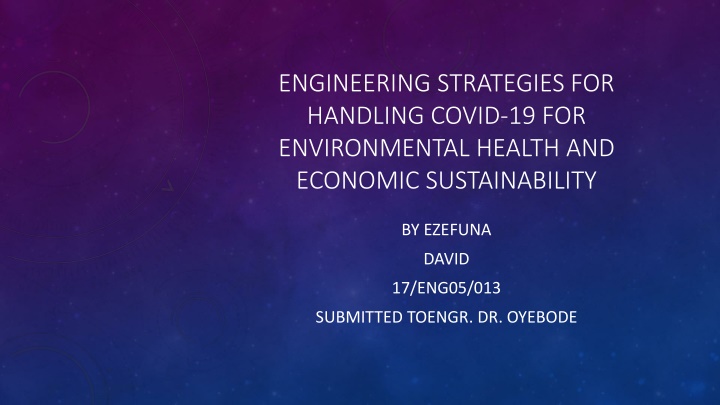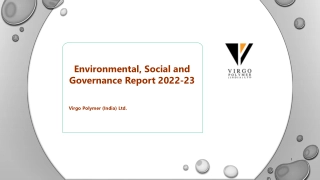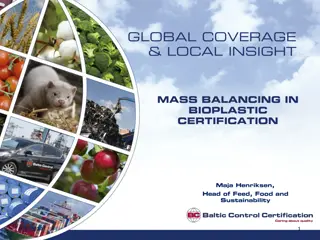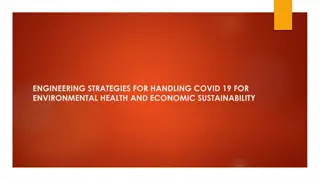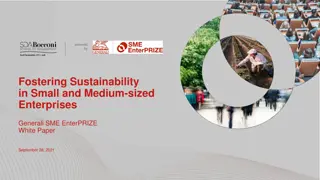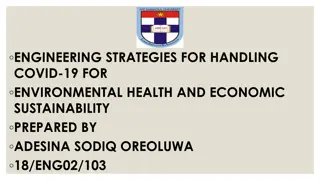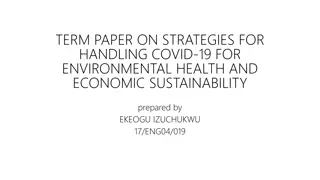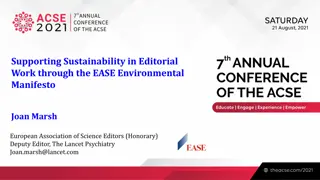Engineering Strategies for Environmental Health and Economic Sustainability Amid COVID-19
COVID-19, caused by SARS-CoV-2, originated in Wuhan, China, in late 2019, impacting industries globally. The disease spreads through close contact with infected persons, affecting economic sustainability. This paper explores strategies to handle COVID-19 for environmental health and economic sustainability, considering the emergence and spread of coronaviruses like SARS and MERS.
Download Presentation

Please find below an Image/Link to download the presentation.
The content on the website is provided AS IS for your information and personal use only. It may not be sold, licensed, or shared on other websites without obtaining consent from the author.If you encounter any issues during the download, it is possible that the publisher has removed the file from their server.
You are allowed to download the files provided on this website for personal or commercial use, subject to the condition that they are used lawfully. All files are the property of their respective owners.
The content on the website is provided AS IS for your information and personal use only. It may not be sold, licensed, or shared on other websites without obtaining consent from the author.
E N D
Presentation Transcript
ENGINEERING STRATEGIES FOR HANDLING COVID-19 FOR ENVIRONMENTAL HEALTH AND ECONOMIC SUSTAINABILITY BY EZEFUNA DAVID 17/ENG05/013 SUBMITTED TOENGR. DR. OYEBODE
TABLE OF CONTENTS Introductions Literature Review Protective Measures Effects of COVID-19 on industries and economic sustainability Handling COVID-19 for environmental health and economic sustainability Conclusion and Recommendation
INTRODUCTIONS COVID-19 is the scientific name given to the coronavirus disease of 2019. It is the name given by the World Health Organization (WHO) on February 11, 2020, for the disease caused by the novel corona virus SARS-CoV-2, which started in Wuhan, China, in late 2019 and has since spread worldwide.On December 31, 2019, a strange new pneumonia of unknown cause was reported to the Chinese WHO Country Office. A cluster of these cases originally appeared in Wuhan, a city in the Hubei Province of China. These infections were found to be caused by a new corona virus which was given the name 2019 novel corona virus (2019-nCoV).
Analysis of emergence and spreading of coronaviruses:As of the year 2003, the Chinese population was infected with a virus causing Severe Acute Respiratory Syndrome (SARS) in Guangdong province. The virus was confirmed as a member of the Beta-coronavirus subgroup and was named SARS-CoV. The infected patients exhibited pneumonia symptoms with a diffused alveolar injury which lead to acute respiratory distress syndrome (ARDS). SARS initially emerged in Guangdong, China and then spread rapidly around the globe with more than 8000 infected persons and 776 deceases. A decade later in 2012, a couple of Saudi Arabian nationals were diagnosed to be infected with another coronavirus. The detected virus was confirmed as a member of coronaviruses and named as the Middle East Respiratory Syndrome Coronavirus (MERS-CoV). The World health organization reported that MERS-coronavirus infected more than 2428 individuals and 838 deaths.
it was suggested that the patients infected with Wuhan coronavirus induced pneumonia in China may have visited the seafood market where live animals were sold or may have used infected animals or birds as a source of food. However, further investigations revealed that some individuals contracted the infection even with no record of visiting the seafood market. These observations indicated a human to the human spreading capability of this virus, which was subsequently reported in more than 100 countries in the world. The human to the human spreading of the virus occurs due to close contact with an infected person, exposed to coughing, sneezing, respiratory droplets or aerosols. These aerosols can penetrate the human body (lungs) via inhalation through the nose or mouth.
LITERATURE REVIEW Automation or automatic control is the use of various control systems for operating equipment such as machinery, processes in factories, boilers and heat treating ovens, switching on telephone networks, steering and stabilization of ships, aircraft and other applications and vehicles with minimal or reduced human intervention. Automation covers applications ranging from a household thermostat controlling a boiler, to a large industrial control system with tens of thousands of input measurements and output control signals. In control complexity, it can range from simple on-off control to multi-variable high-level algorithms. Artificial intelligence (AI), is the ability of a digital computer or computer-controlled robot to perform tasks commonly associated with intelligent beings. The term is frequently applied to the project of developing systems endowed with the intellectual processes characteristic of humans, such as the ability to reason, discover meaning, generalize, or learn from past experience. Since the development of the digital computer in the 1940s, it has been demonstrated that computers can be programmed to carry out very complex tasks, for example, discovering proofs for mathematical theorems or playing chess with great proficiency. Still, despite continuing advances in computer processing speed and memory capacity, there are as yet no programs that can match human flexibility over wider domains or in tasks requiring much everyday knowledge. On the other hand, some programs have attained the performance levels of human experts and professionals in performing certain specific tasks, so that artificial intelligence in this limited sense is found in applications as diverse as medical diagnosis, computer search engines, and voice or handwriting recognition.
PROTECTIVE MEASURES General hygiene Wash your hands frequentlyRegularly and thoroughly clean your hands with an alcohol-based hand rub or wash them with soap and water. Washing your hands with soap and water or using alcohol-based hand rub kills viruses that may be on your hands. Practice respiratory hygiene Make sure you, and the people around you, follow good respiratory hygiene. This means covering your mouth and nose with your bent elbow or tissue when you cough or sneeze. Then dispose of the used tissue immediately. Droplets spread virus. By following good respiratory hygiene you protect the people around you from viruses such as cold, flu and COVID-19. Maintain social distancing Maintain at least 1metre (3 feet) distance between yourself and anyone who is coughing or sneezing. When someone coughs or sneezes they spray small liquid droplets from their nose or mouth which may contain virus. If you are too close, you can breathe in the droplets, including the COVID-19 virus if the person coughing has the disease.
Avoid touching eyes, nose and mouth Hands touch many surfaces and can pick up viruses. Once contaminated, hands can transfer the virus to your eyes, nose or mouth. From there, the virus can enter your body and can make you sick.If you have fever, cough and difficulty breathing, seek medical care earlyStay home if you feel unwell. If you have a fever, cough and difficulty breathing, seek medical attention and call in advance. Follow the directions of your local health authority. National and local authorities will have the most up to date information on the situation in your area. Calling in advance will allow your health care provider to quickly direct you to the right health facility. This will also protect you and help prevent spread of viruses and other infections.Stay informed and follow advice given by your healthcare providerStay informed on the latest developments about COVID-19. Follow advice given by your healthcare provider, your national and local public health authority or your employer on how to protect yourself and others from COVID-19. National and local authorities will have the most up to date information on whether COVID-19 is spreading in your area. They are best placed to advise on what people in your area should be doing to protect themselves.
EFFECTS OF COVID-19 ON INDUSTRIES AND ECONOMIC SUSTAINABILITY The tragic health hazards and human consequences of the COVID-19 pandemic, the economic uncertainties, and disruptions that have resulted come at a significant cost to the global economy. The United Nations Trade and Development Agency (UNCTAD) put the cost of the outbreak at about US$2 trillion in 2020. Most central banks, finance ministries and independent economic experts around the world have taken solace in the prediction that the impacts might be sharp but short-lived, and economic activities would return to normal thereafter. This line of thought mirrors the thinking of the events that shaped the 2007 global financial crisis. However, when compared to COVID-19, the 2007 crisis could be described as minor and manageable. The tumultuous events that COVID-19 has spread across the globe cuts across every facet of human existence and the consequences may linger beyond the second half of 2020.The slowdown in the global economy and lockdown in some countries, such as Italy, Spain and most Euro zone economies and beyond, as a result of COVID-19 has also taken its toll on the global demand for oil. The decline in oil demand is estimated to surpass the loss of nearly 1 million barrels per day during the 2007-08 recession. This is also coming at a time when two key players in the global oil industry Russia and the OPEC cartel are at loggerheads on the decision to cut output. The unequivocal oil price war started between these two global oil market giants may have more dire consequences on the oil price that has started to dive.
HANDLING COVID-19 FOR ENVIRONMENTAL HEALTH AND ECONOMIC SUSTAINABILITY Taking a critical look at the current situation, the best and most effective measure for preventing the spread of the virus is through social distancing. This is best achieved by imposing compulsory lockdowns. These lockdowns affect a lot institutions and gatherings including; schools, markets, manufacturing industries and businesses, religious gatherings and social functions etc. It also affects rates in demand and supply of several commodities and a decline in mobility which is a major source of employment. An increase in everyday necessities such as food, water and toiletries matched with a decrease in their availability due to the lockdown may slowly lead to a breakdown of law and order if prolonged
However the following strategies can be adopted to contain the situation:Automation and Artificial Intelligence as tools for improvementTackling the problems associated with imposing lockdowns requires hand-on relevant and efficient technology. High demand should hence be placed on automation and artificial intelligence, in order to achieve productivity with less human contact and effort, as well as aid delivery and dispensing of items at sale points and aid transportation. Simple safe devices and methods should be adopted to help easy and faster detection prevention and control of possible cases of the virus such as; the drive through tests, hand sanitizer dispensers, smart helmets (as implemented in China). Communication and connectivity: Communication and connectivity is a necessity of this period. It is of great importance that the public be kept informed with the latest updates on information regarding measures for their personal safety, as the virus is being studied and as it evolves. It is also important that individuals are aware of the new laws enacted to contain the situation. Apart from ensuring public awareness, connectivity is also required to keep institutions and businesses on course. To reduce the effect of the lockdown, platforms should be made available to aid online learning for secondary and tertiary institutions, also businesses can also be done using these online platforms as meetings, conferences etc. can be held via a good connection, as well as transactions.
CONCLUSION AND RECOMMENDATION The virus which has began with a slow increase has evolved into an exponential growth curve and will take the work of the planet to change its course. The COVID-19 virus which started in China has spread globally and the resulting deaths are still on the rise. It is therefore highly important that strict measures are put in place to stop the spread of the virus. Individuals should be made to realize that there is currently no vaccine available for its treatment. However the effects of the virus can be greatly reduced by adopting the strategies stated in the previous slides. The effects of a pandemic cut across every facet of human existence. To reduce the effects as well as prevent further spread of the virus, it is important that individuals play their role of strict adherence to personal preventive measures and also the enacted laws which include; lockdowns and travel bans. Handling a pandemic requires hands-on reliable and efficient technology, hence engineering solutions and strategies should be adopted to aid the prevention and control of the virus.
